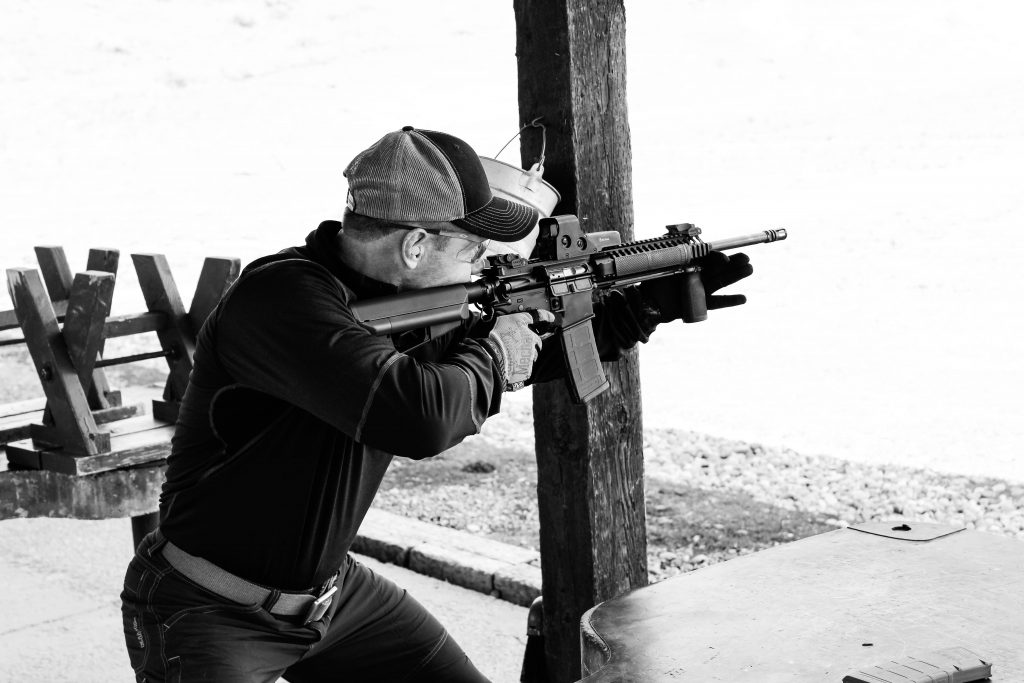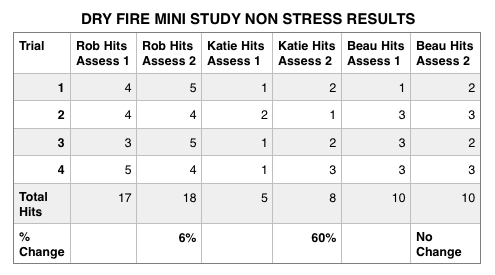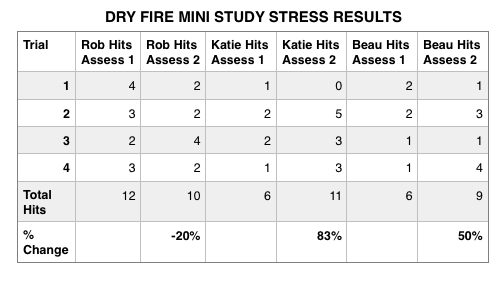
By Rob Shaul
This “Mini Study” was to assess the effects dry fire practice has on actual marksmanship. The results were not what we’d hoped for.
Why a Dry Fire Study?
The results from our Trigger Pull Study were statistically inconclusive because some of the individual Fresno part-time SWAT team members we used as lab rats had widely variable marksmanship results between the first and second trial. The team members get together to train either one day, or two days/month and have to work in that training time all their training requirements – including marksmanship.
We felt one possible reason for the inconsistent shooting was simply that the team members didn’t get much time on the range with their long rifles. Most SWAT teams are part-time, and we reasoned this was a common issue.
As well, we know on the military side, many line units are lucky to get to the range once per quarter.
Recommending tactical athletes spend more time at the range is an obvious recommendation, but doesn’t reflect the realities for most of of available training time, range access, ammunition, etc.
So, is there a way we can improve marksmanship without actual range time? Finding and validating an efficient, cheap, safe and effective, non-live fire methodology to improve marksmanship would be a great “mission-direct” tool for military and LE athletes everywhere.
Two low-cost options present themselves: dry fire work and cheap airsoft target practice.
We began with dry fire work and decided to conduct a mini-study amongst our office staff.
Why a Mini-Study?
A small, quick mini-study is a great tool for us to accomplish several things before conducting a larger, longer, more involved study.
First, we test the practicality and “churn” the testing protocols in the study.
In this case, while we could find expert marksman referring to dry fire work, we were unable to find a specific, choreographed dry fire protocol. We had to develop our own dry fire protocol and evaluate it for time, practicality and effectiveness.
Same with the range assessment for this study – conducting a mini-study allowed me to test the warm up at the range, assessment – non stress and stress, target size and distance, overall time, etc.
Second, mini study results can often help us quickly identify obvious paths to follow with further research. They can, but don’t always – and didn’t in this case, which I’ll describe below.
Study Methodology, Assumptions, and Hypothesis
Lab Rats & Groups
Three of use served as “lab rats.” Myself and our Development & Operations Lead, Beau, served as the “Study Group.” We’d do the dry fire drills.
Katie, our Marketing & Operations Lead, served as the “Control Group.”
I’m the most experienced marksman. Both Beau and Katie have shot AR’s, but don’t frequently, and thus are somewhat similar to military and LE athletes who rarely get range time.
Assess, Treatments, Re-Assess
Both the Study and Control Groups began the study with a live-fire marksmanship assessment at the range. We did this Monday. (Scroll down for details and video.)
Next, the “Study Group” (Beau and I) completed 3x dry fire “treatments” in the office. We completed a 30 minute protocol Tuesday, Wednesday and Thursday. (Scroll down for details and video.)
Thursday late morning, all three of us returned to the range and Re-Assessed using the same exact protocol as Monday’s initial assessment.
Assumptions & Hypothesis
I assumed each of us would improve on the second assessment regardless, simply because we were familiar with the assessment and had shot earlier in the week.
I hypothesized both my and Beau’s improvement on the second assessment would be greater than Katie’s because we had completed the dry fire work, and she hadn’t. This would point to dry fire work as a possible tool to improve marksmanship.
Results
Contrary to my hypothesis, Katie improved on the assessments (60% Non-Stress, 83% Stress) much greater than Beau and I, though she didn’t not complete the dry fire protocols.
I improved slightly on the Non-Stress re-assessment (6%), but actually dropped on the Stress assessment by 20%.
Beau had no change on the Non-Stress re-assessment, but did improve by 50% on the Stress Assessment.
Because there were so few of us, these results were not statistically significant. Again, we used this mini study to make sure we were headed in the right direction.


Discussion
What happened? Not sure…
It could be that dry fire work doesn’t improve marksmanship.
It could be our dry fire protocol is flawed – though it matched the same number of trigger pulls and same shooting positions as the assessment.
It could be the study was not long enough and the study group needed more dry fire “treatments” for the effects to show up in the assessment results.
It could be we simply had too few lab rats, and greater numbers would have led to more conclusive results.
Where to Now?
Next here at Mountain Tactical we’ll do a similar Mini Study replacing the dry-fire practice with Airsoft rifle target practice in the office. Perhaps the simple reinforcement of a hit or non-hit of the bullseye will greatly increase the value of the non-live fire training. Look for the results soon.
Externally, we have a Canadian unit interested in conducting the dry fire study. If the unit gets command approval, we’ll extend the study to 2 weeks and increase the dry fire treatments for the Study Group – and see if that makes a difference.
Questions,Comments, Feedback? Email rob@mtntactical.com
Specific Assessment and Dry Fire Protocols
Assessment Protocol
Target: 8” Metal
Distance: 80 Yards (10 MOA)
Shooting Positions: Unsupported Standing and Kneeling
Total Ammo: 56x Rounds
Warm Up:
a) 2 Times Through
3x Ready Up to Standing
b) 2 Times Through
3x Read Up to Kneeling
c) 1 Magazine, 8x Live Rounds
2 Times Through – No Time Limit
2x Shots Standing
2x Shots Kneeling
(1) Non-Stress Trials
4 Times Through (24x Shots Total)
Load: 1 Magazine, 6x Live Rounds
Time Limit: None
Target: 8” Metal
Distance: 80 Yards (10 MOA)
Protocol:
On “Commence Fire”
3x Shots Standing
3x Shots Kneeling
Record Total Hits
(2) Stress Trials
4 Times Through (24x Shots Total)
Load: 1 Magazine, 6x Live Rounds
Time Limit: 15 Seconds
Target: 8” Metal
Distance: 80 Yards (10 MOA)
Protocol:
On “Commence Fire”
3x Shots Standing
3x Shots Kneeling
Record Total Hits made within Time Limit
Dry Fire Protocol
2x Athletes, 1x Weapon
Target: 1” Dot on White Board
Distance: Approx. 25 Feet
Time: Approx 30 Minutes
Overall Trigger Pulls: 48x (same as the assessment)
a) 2 Times Through
3x Read Up Standing
b) 2 Times Through
3x Read Up Kneeling
c) 2 Times Through
3x Read Up Standing to Kneeling
d) 2 Times Through
3x Read Up Standing with Trigger Pull
e) 2 Times Through
3x Read Up Kneeling with Trigger Pull
f) 2 Times Through
3x Read Up Standing with Trigger Pull to Kneeling with Trigger Pull
g) 2 Times Through with 3 Sec Time Limit
3x Read Up Standing with Trigger Pull
h) 2 Times Through with 3 Sec Time Limit
3x Read Up Kneeling with Trigger Pull
j) 2 Times Through with 6 Sec Time Limit
3x Read Up Standing with Trigger Pull to Kneeling with Trigger Pull
You Might Also Like MTI’s Range Fitness Mid-Range Carbin